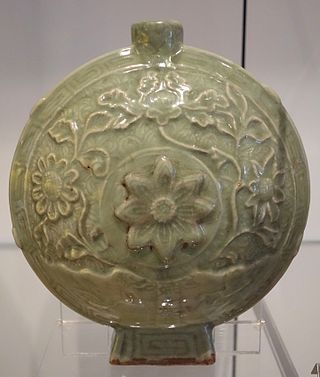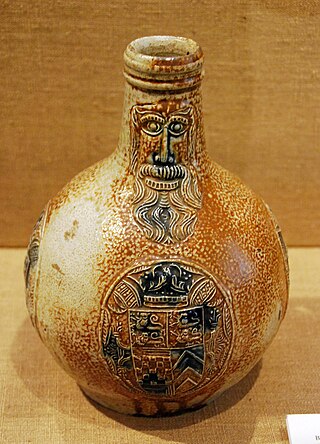
Pottery is the process and the products of forming vessels and other objects with clay and other raw materials, which are fired at high temperatures to give them a hard and durable form. The place where such wares are made by a potter is also called a pottery. The definition of pottery, used by the ASTM International, is "all fired ceramic wares that contain clay when formed, except technical, structural, and refractory products". End applications include tableware, decorative ware, sanitary ware, and in technology and industry such as electrical insulators and laboratory ware. In art history and archaeology, especially of ancient and prehistoric periods, pottery often means only vessels, and sculpted figurines of the same material are called terracottas.

Raku ware is a type of Japanese pottery traditionally used in Japanese tea ceremonies, most often in the form of chawan tea bowls. It is traditionally characterised by being hand-shaped rather than thrown, fairly porous vessels, which result from low firing temperatures, lead glazes and the removal of pieces from the kiln while still glowing hot. In the traditional Japanese process, the fired raku piece is removed from the hot kiln and is allowed to cool in the open air.

Longquan celadon is a type of green-glazed Chinese ceramic, known in the West as celadon or greenware, produced from about 950 to 1550. The kilns were mostly in Lishui prefecture in southwestern Zhejiang Province in the south of China, and the north of Fujian Province. Overall a total of some 500 kilns have been discovered, making the Longquan celadon production area one of the largest historical ceramic producing areas in China. "Longquan-type" is increasingly preferred as a term, in recognition of this diversity, or simply "southern celadon", as there was also a large number of kilns in north China producing Yaozhou ware or other Northern Celadon wares. These are similar in many respects, but with significant differences to Longquan-type celadon, and their production rose and declined somewhat earlier.

Pottery and porcelain is one of the oldest Japanese crafts and art forms, dating back to the Neolithic period. Types have included earthenware, pottery, stoneware, porcelain, and blue-and-white ware. Japan has an exceptionally long and successful history of ceramic production. Earthenwares were made as early as the Jōmon period, giving Japan one of the oldest ceramic traditions in the world. Japan is further distinguished by the unusual esteem that ceramics hold within its artistic tradition, owing to the enduring popularity of the tea ceremony. During the Azuchi-Momoyama period (1573-1603), kilns throughout Japan produced ceramics with unconventional designs. In the early Edo period, the production of porcelain commenced in the Hizen-Arita region of Kyushu, employing techniques imported from Korea. These porcelain works became known as Imari wares, named after the port of Imari from which they were exported to various markets, including Europe.

Celadon is a term for pottery denoting both wares glazed in the jade green celadon color, also known as greenware or "green ware", and a type of transparent glaze, often with small cracks, that was first used on greenware, but later used on other porcelains. Celadon originated in China, though the term is purely European, and notable kilns such as the Longquan kiln in Zhejiang province are renowned for their celadon glazes. Celadon production later spread to other parts of East Asia, such as Japan and Korea, as well as Southeast Asian countries, such as Thailand. Eventually, European potteries produced some pieces, but it was never a major element there. Finer pieces are in porcelain, but both the color and the glaze can be produced in stoneware and earthenware. Most of the earlier Longquan celadon is on the border of stoneware and porcelain, meeting the Chinese but not the European definitions of porcelain.

Salt-glaze or salt glaze pottery is pottery, usually stoneware, with a ceramic glaze of glossy, translucent and slightly orange-peel-like texture which was formed by throwing common salt into the kiln during the higher temperature part of the firing process. Sodium from the salt reacts with silica in the clay body to form a glassy coating of sodium silicate. The glaze may be colourless or may be coloured various shades of brown, blue, or purple.

Slipware is pottery identified by its primary decorating process where slip is placed onto the leather-hard (semi-hardened) clay body surface before firing by dipping, painting or splashing. Slip is an aqueous suspension of a clay body, which is a mixture of clays and other minerals such as quartz, feldspar and mica. The slip placed onto a wet or leather-hard clay body surface by a variety of techniques including dipping, painting, piping or splashing. Slipware is the pottery on which slip has been applied either for glazing or decoration. Slip is liquified clay or clay slurry, with no fixed ratio of water and clay, which is used either for joining pottery pieces together by slip casting with mould, glazing or decorating the pottery by painting or dipping the pottery with slip.

Ding ware, Ting ware or Dingyao are Chinese ceramics, mostly porcelain, that were produced in the prefecture of Dingzhou in Hebei in northern China. The main kilns were at Jiancicun or Jianci in Quyang County. They were produced between the Tang and Yuan dynasties of imperial China, though their finest period was in the 11th century, under the Northern Song. The kilns "were in almost constant operation from the early eighth until the mid-fourteenth century."

Chinese ceramics are one of the most significant forms of Chinese art and ceramics globally. They range from construction materials such as bricks and tiles, to hand-built pottery vessels fired in bonfires or kilns, to the sophisticated Chinese porcelain wares made for the imperial court and for export.

Jun ware is a type of Chinese pottery, one of the Five Great Kilns of Song dynasty ceramics. Despite its fame, much about Jun ware remains unclear, and the subject of arguments among experts. Several different types of pottery are covered by the term, produced over several centuries and in several places, during the Northern Song dynasty (960–1127), Jin dynasty (1115–1234) and Yuan dynasty (1271–1368), and lasting into the early Ming dynasty (1368–1644).

Ceramic glaze, or simply glaze, is a glassy coating on ceramics. It is used for decoration, to ensure the item is impermeable to liquids and to minimise the adherence of pollutants.
This is a list of pottery and ceramic terms.

Sancai is a versatile type of decoration on Chinese pottery using glazes or slip, predominantly in the three colours of brown, green, and a creamy off-white. It is particularly associated with the Tang dynasty (618–907) and its tomb figures, appearing around 700. Therefore, it is commonly referred to as Chinese: 唐三彩 Tang Sancai in Chinese. Tang sancai wares were sometimes referred in China and the West as egg-and-spinach by dealers, for their use of green, yellow, and white, especially when combined with a streaked effect.

Shiwan ware is Chinese pottery from kilns located in the Shiwanzhen Subdistrict of the provincial city of Foshan, near Guangzhou, Guangdong. It forms part of a larger group of wares from the coastal region known collectively as "Canton stonewares". The hilly, wooded, area provided slopes for dragon kilns to run up, and fuel for them, and was near major ports.

Qingbai ware is a type of Chinese porcelain produced under the Song Dynasty and Yuan dynasty, defined by the ceramic glaze used. Qingbai ware is white with a blue-greenish tint, and is also referred to as Yingqing. It was made in Jiangxi province in south-eastern China, in several locations including Jingdezhen, and is arguably the first type of porcelain to be produced on a very large scale. However, it was not at the time a prestigious ware, and was mostly used for burial wares and exports, or a middle-rank Chinese market. The quality is very variable, reflecting these different markets; the best pieces can be very thin-walled.

Yue ware or Yüeh ware is a type of Chinese ceramics, a felspathic siliceous stoneware, which is characteristically decorated with celadon glazing. Yue ware is also sometimes called (Yuezhou) green porcelain in modern literature, but the term is misleading as it is not really porcelain and its shades are not really green. It has been "one of the most successful and influential of all south Chinese ceramics types".

Cizhou ware or Tz'u-chou ware is a wide range of Chinese ceramics from between the late Tang dynasty and the early Ming dynasty, but especially associated with the Northern Song to Yuan period in the 11–14th century. It has been increasingly realized that a very large number of sites in northern China produced these wares, and their decoration is very variable, but most characteristically uses black and white, in a variety of techniques. For this reason Cizhou-type is often preferred as a general term. All are stoneware in Western terms, and "high-fired" or porcelain in Chinese terms. They were less high-status than other types such as celadons and Jun ware, and are regarded as "popular", though many are finely and carefully decorated.

Guan ware or Kuan ware is one of the Five Famous Kilns of Song dynasty China, making high-status stonewares, whose surface decoration relied heavily on crackled glaze, randomly crazed by a network of crack lines in the glaze.

Yaozhou ware is a type of celadon or greenware in Chinese pottery, which was at its height during the Northern Song dynasty. It is the largest and typically the best of the wares in the group of Northern Celadon wares. It is especially famous for the rich effects achieved by decoration in shallow carving under a green celadon glaze which sinks into the depressions of the carving giving contrasts of light and dark shades.

A dragon kiln or "climbing kiln", is a traditional Chinese form of kiln, used for Chinese ceramics, especially in southern China. It is long and thin, and relies on having a fairly steep slope, typically between 10° and 16°, up which the kiln runs. The kiln could achieve the very high temperatures, sometimes as high as 1400 °C, necessary for high-fired wares including stoneware and porcelain, which long challenged European potters, and some examples were very large, up to 60 metres long, allowing up to 25,000 pieces to be fired at a time. By the early 12th century CE they might be over 135 metres long, allowing still larger quantities to be fired; more than 100,000 have been claimed.




















